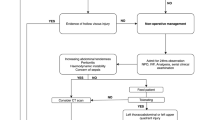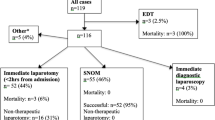Abstract
Introduction
The management of haemodynamically stable patients who present following a penetrating abdominal injury (PAI) remains variable between mandatory surgical exploration and more selective non-operative approaches. The primary aim of this study was to assess compliance with an algorithm guiding selective non-operative management of haemodynamically stable patients with PAI. The secondary aim was to examine the association between compliance and unnecessary laparotomies.
Methods
This was a retrospective cohort study involving all patients with PAI that presented to a major trauma centre from January 2007 to December 2011. Data were extracted from the trauma registry and patients’ electronic medical records.
Results
There were 189 patients included in the study, of which 79 (41.8 %) patients complied with the algorithm. The laparotomy rate in the setting of algorithm compliance was significantly lower than algorithm non-compliance (12.7 vs. 68.2 %; p < 0.01) as were unnecessary laparotomy rates (0 vs. 33.3 %; p = 0.03).
Conclusion
Among haemodynamically stable patients presenting with PAI, compliance with an algorithm guiding selective non-operative management was low, but associated with lower laparotomy and lower unnecessary laparotomy rates. Improved compliance with algorithms directed towards selective non-operative management of PAI should be encouraged with stringent vigilance towards patient safety.



Similar content being viewed by others
Abbreviations
- PAI:
-
Penetrating abdominal injury
- ED:
-
Emergency department
- SNOM:
-
Selective non-operative management
- MTS:
-
Major trauma services
- ISS:
-
Injury severity score
- ICU:
-
Intensive care unit
- FAST:
-
Focused assessment with sonography for trauma
- OT:
-
Operating theatre
- CT:
-
Computed tomography
- SBP:
-
Systolic blood pressure
- HR:
-
Heart rate
References
O’Mullane PA, Mikocka-Walus AA, Gabbe BJ, Cameron PA. Incidence and outcomes of major trauma assaults: a population-based study in Victoria. Med J Aust. 2009;190:129–32.
Ogilvie R, Curtis K, Palmer C, Lam M, McCloughen A, Foster K. Incidence and outcomes of major trauma patients managed in the Australian Capital Territory. ANZ J Surg. 2014;84:433–7.
Boyle MJ, Smith EC, Archer FL. Trauma incidents attended by emergency medical services in Victoria, Australia. Prehosp Disaster Med. 2008;23:20–8.
Smith GA. Knife-related injuries treated in United States emergency departments, 1990–2008. J Emerg Med. 2013;45:315–23.
Mendes JF, Mathee A, Naicker N, Becker P, Naidoo S. The prevalence of intentional and unintentional injuries in selected Johannesburg housing settlements. S Afr Med J =Suid-Afrikaanse tydskrif vir geneeskunde. 2011;101(835–6):38.
Rozen WM, Ma EH, Jones IT, Judson RT. Emerging epidemic in Australia: abdominal stab wounds. Twenty-four months at a major trauma centre. Emerg Med Aust: EMA. 2007;19:262–8.
Rotondo MF, Schwab CW, McGonigal MD, et al. ‘Damage control’: an approach for improved survival in exsanguinating penetrating abdominal injury. J Trauma. 1993;35:375–82 (discussion 82–3).
Sugrue M, Balogh Z, Lynch J, Bardsley J, Sisson G, Weigelt J. Guidelines for the management of haemodynamically stable patients with stab wounds to the anterior abdomen. ANZ J Surg. 2007;77:614–20.
Schmelzer TM, Mostafa G, Gunter OL Jr, Norton HJ, Sing RF. Evaluation of selective treatment of penetrating abdominal trauma. J Surg Educ. 2008;65:340–5.
Nicholas JM, Rix EP, Easley KA, et al. Changing patterns in the management of penetrating abdominal trauma: the more things change, the more they stay the same. J Trauma. 2003;55:1095–108 (discussion 108–10).
Ball CG. Current management of penetrating torso trauma: nontherapeutic is not good enough anymore. Can J Surg Journal canadien de chirurgie. 2014;57:E36–43.
Cothren CC, Moore EE, Warren FA, Kashuk JL, Biffl WL, Johnson JL. Local wound exploration remains a valuable triage tool for the evaluation of anterior abdominal stab wounds. Am J Surg. 2009;198:223–6.
Biffl WL, Kaups KL, Cothren CC, et al. Management of patients with anterior abdominal stab wounds: a Western Trauma Association multicenter trial. J Trauma. 2009;66:1294–301.
Jansen JO, Inaba K, Rizoli SB, Boffard KD, Demetriades D. Selective non-operative management of penetrating abdominal injury in Great Britain and Ireland: survey of practice. Injury. 2012;43:1799–804.
Mitra B, Gocentas R, O’Reilly G, Cameron PA, Atkin C. Management of haemodynamically stable patients with abdominal stab wounds. Emerg Med Aust: EMA. 2007;19:269–75.
Gilbert EH, Lowenstein SR, Koziol-McLain J, Barta DC, Steiner J. Chart reviews in emergency medicine research: where are the methods? Ann Emerg Med. 1996;27:305–8.
Ertekin C, Yanar H, Taviloglu K, Guloglu R, Alimoglu O. Unnecessary laparotomy by using physical examination and different diagnostic modalities for penetrating abdominal stab wounds. Emerg Med J: EMJ. 2005;22:790–4.
Khanna S, Boyle J, Good N, Lind J. New emergency department quality measure: from access block to National Emergency Access Target compliance. Emerg Med Aust: EMA. 2013;25:565–72.
Perera ML, Davies AW, Gnaneswaran N, et al. Clearing emergency departments and clogging wards: national Emergency Access Target and the law of unintended consequences. Emerg Med Aust: EMA. 2014;26:549–55.
Como JJ, Bokhari F, Chiu WC, et al. Practice management guidelines for selective nonoperative management of penetrating abdominal trauma. J Trauma. 2010;68:721–33.
Beitner MM, Suh N, Dowling R, Miller JA. Penetrating liver injury managed with a combination of balloon tamponade and venous stenting: a case report and literature review. Injury. 2012;43:119–22.
Clarke DL, Allorto NL, Thomson SR. An audit of failed non-operative management of abdominal stab wounds. Injury. 2010;41:488–91.
Navsaria PH, Berli JU, Edu S, Nicol AJ. Non-operative management of abdominal stab wounds–an analysis of 186 patients. S Afr J Surg Suid-Afrikaanse tydskrif vir chirurgie. 2007;45:128–30, 32.
Demetriades D, Hadjizacharia P, Constantinou C, et al. Selective nonoperative management of penetrating abdominal solid organ injuries. Ann Surg. 2006;244:620–8.
Acknowledgments
We would like to thank the staff at the Medical Records department of The Alfred Hospital for making patient histories available for review.
Author information
Authors and Affiliations
Corresponding author
Ethics declarations
All human and animal studies have been approved by the appropriate ethics committee and have therefore been performed in accordance with the ethical standards laid down in the 1964 Declaration of Helsinki and its later amendments. Specific national laws have been observed.
Conflict of interest
Jasmina Kevric, Gerard O’Reilly, Robert Gocentas, Orcun Hasip, Charles Pilgrim and Biswadev Mitra have no conflict of interest or financial support to declare.
Rights and permissions
About this article
Cite this article
Kevric, J., O’Reilly, G.M., Gocentas, R.A. et al. Management of haemodynamically stable patients with penetrating abdominal stab injuries: review of practice at an Australian major trauma centre. Eur J Trauma Emerg Surg 42, 671–675 (2016). https://doi.org/10.1007/s00068-015-0605-x
Received:
Accepted:
Published:
Issue Date:
DOI: https://doi.org/10.1007/s00068-015-0605-x




